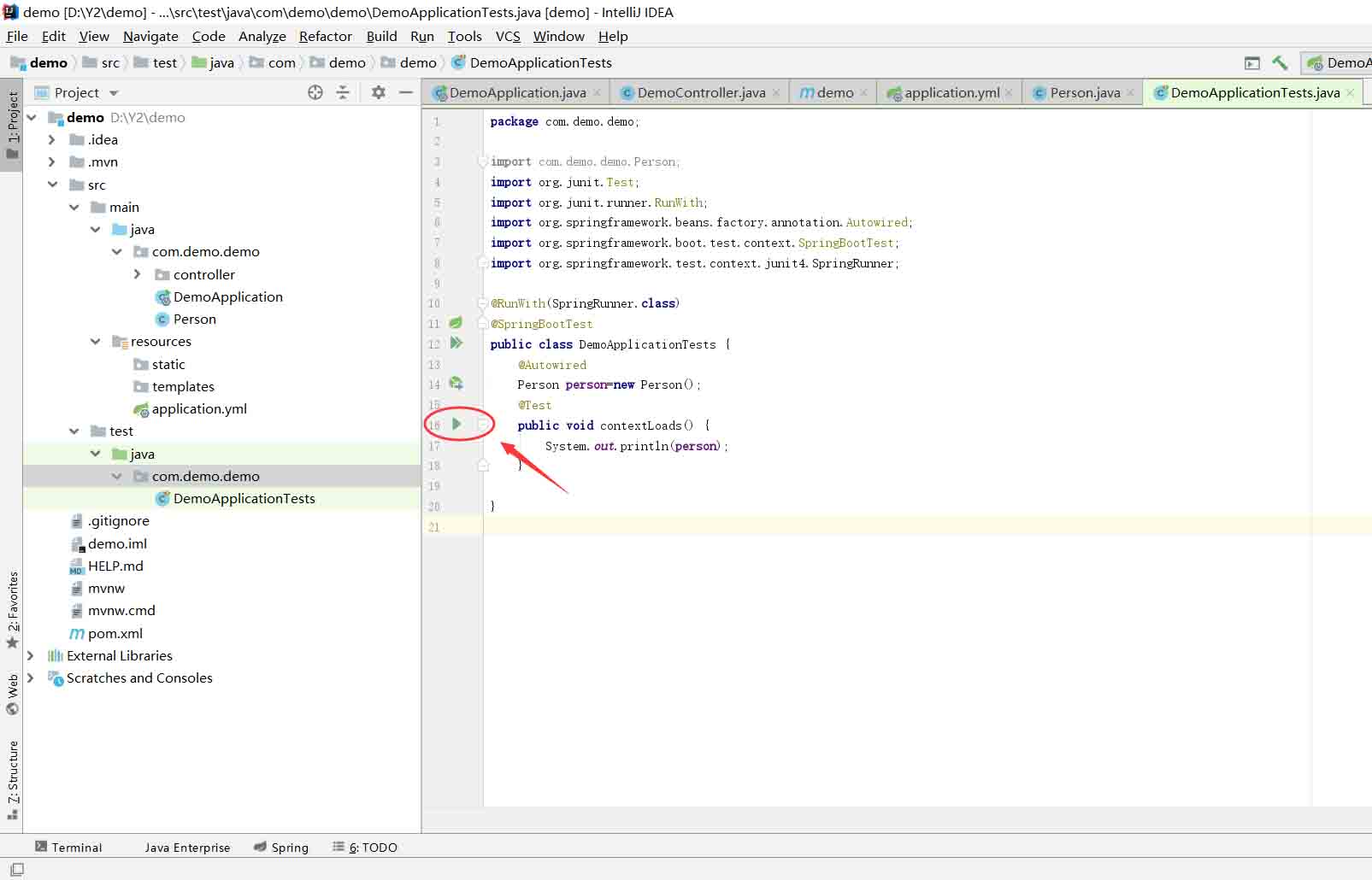这篇文章跟大家分析一下“springboot yml配置文件值的注入方式是什么”。内容详细易懂,对“springboot yml配置文件值的注入方式是什么”感兴趣的朋友可以跟着小编的思路慢慢深入来阅读一下,希望阅读后能够对大家有所帮助。下面跟着小编一起深入学习“springboot yml配置文件值的注入方式是什么”的知识吧。
yml配置文件值注入
搭建项目
参考 IDEA快速搭建spring-boot项目(Spring initializr)
pom.xml
创建项目后,还需在pom.xml中的<dependencies>标签添加该依赖。
<dependency><groupId>org.springframework.boot</groupId><artifactId>spring-boot-configuration-processor</artifactId><optional>true</optional></dependency>创建实体类
package com.demo.demo;import org.springframework.boot.context.properties.ConfigurationProperties;import org.springframework.stereotype.Component;@Component@ConfigurationProperties(prefix = "person")public class Person { private String name; private int age; @Override public String toString() { return "person{" + "name='" + name + '\'' + ", age=" + age + '}'; } public String getName() { return name; } public void setName(String name) { this.name = name; } public int getAge() { return age; } public void setAge(int age) { this.age = age; }}spring boot核心配置文件application.yml
将application.properties文件后缀改为.yml,内容为:
server: port: 8080person: name: 小狗 age: 21测试类
package com.demo.demo;import com.demo.demo.Person;import org.junit.Test;import org.junit.runner.RunWith;import org.springframework.beans.factory.annotation.Autowired;import org.springframework.boot.test.context.SpringBootTest;import org.springframework.test.context.junit4.SpringRunner;@RunWith(SpringRunner.class)@SpringBootTestpublic class DemoApplicationTests { @Autowired Person person=new Person(); @Test public void contextLoads() { System.out.println(person); }}运行

结果:

自动注入yml文件和properties文件
在springboot中,如果需要使用到配置文件中的数据,自动注入即可,非常方便,但是在使用yml中的属性时,自动注入却失效了? 发现,如果是properties文件,直接注入即可,但是yml需要增加一个配置
yml文件的自动注入class
yml文件相对于properties较整洁和简便,在自动注入的使用需要增加配置
增加pom依赖
<!--*.yml auto inject config--> <dependency> <groupId>org.springframework.boot</groupId> <artifactId>spring-boot-configuration-processor</artifactId> <optional>true</optional> </dependency>增加配置类
public class YamlPropertyLoaderFactory extends DefaultPropertySourceFactory { @Override public PropertySource<?> createPropertySource(String name, EncodedResource resource) throws IOException { if (null == resource) { super.createPropertySource(name, resource); } return new YamlPropertySourceLoader().load(resource.getResource().getFilename(), resource.getResource(),null); }}注入指定yml配置文件到实体类中
@Configuration@PropertySource(value = "classpath:application-quartz.yml", factory = YamlPropertyLoaderFactory.class)@ConfigurationProperties(prefix = "quartz")public class JobTime { private String articleCarwler; private String earthlySweetSentenceApi; private String rainbowFartApi; private String qqRobotMsgTimer;}说明:
@PropertySource(value = "classpath:application-quartz.yml", factory = YamlPropertyLoaderFactory.class)这个注解表示注入哪个配置文件,指定第二步中的配置类
@ConfigurationProperties(prefix = "quartz")表示指定配置文件中的属性是什么前缀,可忽略,例如:quartz.articleCarwler=0 0/5 * * * ?
Properties配置文件自动注入
properties类型的配置文件就比较简单,不需要增加上面的依赖和配置,直接指定注入即可
直接注入属性到class
@Configuration@PropertySource("classpath:/application.properties")@ConfigurationProperties(prefix = "quartz")public class JobTime { private String task1; private String task2;}说明:
@PropertySource("classpath:/application.properties")指定配置文件名称
@ConfigurationProperties(prefix = "quartz")指定配置文件中的key的前缀,可忽略此注解, 例如:quartz.task1=0 3 * * * ?
代码中直接注入
如果是在代码中使用单独的属性,不需要将属性都注入到class中,那么可直接使用注解注入到变量中,在代码中直接使用
无论是yml还是properties都可以直接注入,不需要其他配置
使用注解:@Value("${key}") 就可以直接注入。
例如:
@Value("${quartz.taks1}") private String taks1;springboot是什么
springboot一种全新的编程规范,其设计目的是用来简化新Spring应用的初始搭建以及开发过程,SpringBoot也是一个服务于框架的框架,服务范围是简化配置文件。
关于springboot yml配置文件值的注入方式是什么就分享到这里啦,希望上述内容能够让大家有所提升。如果想要学习更多知识,请大家多多留意小编的更新。谢谢大家关注一下编程网网站!




